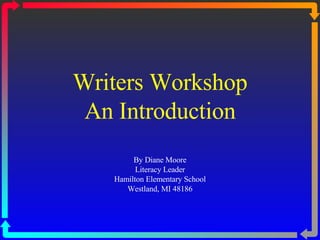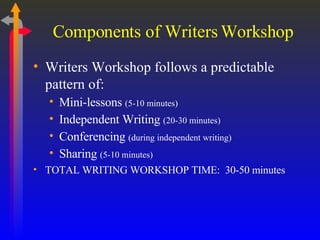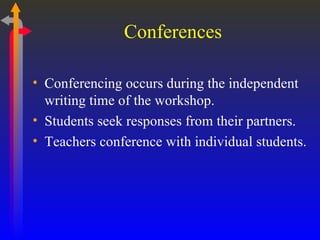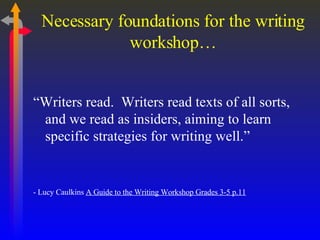Writer's Workshop An Introduction
- 1. Writers Workshop An Introduction By Diane Moore Literacy Leader Hamilton Elementary School Westland, MI 48186
- 2. Ponder thisĪŁ Ī░ There is a great deal of data suggesting that improvements in writing will have a payoff across the curriculum.Ī▒ - Lucy Caulkins A Guide to the Writing Workshop Grades 3-5
- 3. What is Writers Workshop? Writers Workshop is a framework for writing instruction and practice in the classroom.
- 4. Components of Writers Workshop Writers Workshop follows a predictable pattern of: Mini-lessons (5-10 minutes) Independent Writing (20-30 minutes) Conferencing (during independent writing) Sharing (5-10 minutes) TOTAL WRITING WORKSHOP TIME: 30-50 minutes
- 5. What are Mini-lessons? A Mini-lesson is explicit instruction in a specific writing technique taught in a short 5-10 minute period at the start of the workshop. There are 4 types of writing mini-lessons: Procedures and Organization - routines Strategies and Processes Skills Craft and Techniques
- 6. Independent Writing Students write daily. Students determine the topics they will write about. Students use a writerĪ»s notebook and/or folder for organizing writing. Students are at different stages of writing. TeacherĪ»s role is facilitatorĪŁcirculating the room, monitoring, encouraging, conferencing, and providing help as needed. Ī░ When youĪ»re done, youĪ»ve just begun.Ī▒
- 7. Conferences Conferencing occurs during the independent writing time of the workshop. Students seek responses from their partners. Teachers conference with individual students.
- 8. Sharing This is an integral part to the writerĪ»s workshop. Students are given opportunities to share their writing piece. This time allows writers to learn from each other and to see/hear good examples of writing. This time also allows for students to practice speaking orally.
- 9. Writers Notebook Constant composition - These may lead to larger pieces of writing ĪŁ they may not. A place to write What moves you? Heart Mapping What really matters? What in my life, in this world, do I never want to forget? What haunts me? Odd facts, questions, odds and ends, lists, insights, quotes Stop and smell the roses Conversations, language, words
- 10. Procedures for Writers Workshop Procedures make your classroom run smoothly. Procedures may include when students can sharpen their pencils, where to find important papers, or what to do if they need to use the restroom. The following are examples of what may be included in a classroomĪ»s procedures.
- 11. Procedures for Writers Workshop Save Everything Date and Label Everything Write on one side of the paper and skip lines on a draft Write in ink so I can see your editsĪŁnever erase on your draft pieces. Understand that writing is thinking. Do nothing to distract me or other writers. When you confer with me or others ©C use a 6 inch voice When you are stuck, use the resources in the room and the techniques you have been shown to help you
- 12. Necessary foundations for the writing workshopĪŁ Ī░ We need to teach every child to write. Almost every day, every K-5 child needs between fifty and sixty minutes for writing and writing instruction.Ī▒ ©C Lucy Caulkins A Guide to the Writing Workshop Grades 3-5 p.7
- 13. Necessary foundations for the writing workshopĪŁ Ī░ Writers do not write with words and convention alone; writers write above all with meaning. Children will invest themselves more in their writing if they are allowed ©C indeed, if they are taught ©C to select their own topics and to write about subjects that are important to them.Ī▒ -Lucy Caulkins A Guide to the Writing Workshop Grades 3-5 p.9
- 14. Necessary foundations for the writing workshopĪŁ Ī░ Children deserve to be explicitly taught the skills and strategies of effective writing, and the qualities of good writing.Ī▒ - Lucy Caulkins A Guide to the Writing Workshop Grades 3-5 p.10
- 15. Necessary foundations for the writing workshopĪŁ Ī░ Writers read. Writers read texts of all sorts, and we read as insiders, aiming to learn specific strategies for writing well.Ī▒ - Lucy Caulkins A Guide to the Writing Workshop Grades 3-5 p.11
- 16. Benefits of Writers Workshop Prioritizes writing instruction. There is no time wasted with students waiting for other students to finish. Students develop independence and motivation to be writers. Students learn to evaluate their own writing in order to improve it. The more children writeĪŁand write about what really matters to themĪŁthe greater their chance of growing into able thinkers. Sets a collaborative tone to the classroom. Addresses the needs of differentiated instruction.
- 17. In closing, a few notesĪŁ Flexible model. Provides the framework for your writing instruction. Where does W-W stand on this approach? MEAP scores Kits district-wide Inservice byW-W
















